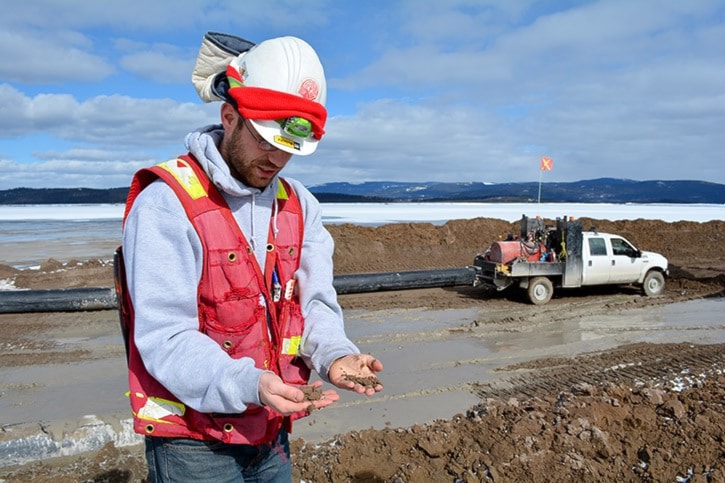Mount Polley Mine north east of Williams Lake near the town of Likely is busy around the clock, with production taking place 24/7 and 300 employees working 12-hour shifts.
In 2013 the mine produced 38.5 million pounds of copper, which was up 14 per cent from 2012’s production of 33.79 million pounds.
“We produce 20,000 to 22,000 tons a day of copper ore concentrate,” said the company’s project mining engineer Luke Moger during a tour last week.
The concentrate is trucked to Vancouver and sold, predominantly to markets in Asia.
Presently the mine’s life spans to 2016, however, Imperial Metals is working on plans to extend its life to 2023.
Aside from the daily operations of running the mine, crews have been busy working on the tailings storage facility during the winter months.
“You are always exploring as you’re producing,” Moger explained while standing on one side of the tailings dam.
“They didn’t know how big the mine was going to be when it first started so in order to keep the tailings storage facility here they had to add this dam and in the last few years added another dam on the other end.”
Working with the existing topography, the dams are built up to ensure the tailings are contained, he added.
There are a few different zones to each dam with five specific kinds of material — non-acid generating rock, also used for roads on site, two manufactured acid filters with different thicknesses and till, which forms a barrier, and finally on the inside is sand.
“Tailings basically come out looking like sand by the time it’s all ground down,” he explained.
Instruments along the dam measure physical movement to monitor how the dam is displacing and others measure water pressure.
Results are sent along to an independent engineering consultant in Vancouver to keep track of how the dam is working over time.
“It gives everyone a bit of comfort that it’s been vetted by a third party,” Moger continued.
Mining in 2013 focused on the Springer Phase 3 and the adjacent Cariboo pit. The majority of ore feed was sourced from Springer Phase 3, and the bulk of stripping activities was in the Cariboo pit.
Over time the two pits, which are close in proximity, will be operating as one.
The Wight Pit, which was exhausted, will be going into production this year as an underground mining operation.
“It will be the first time we do any underground mining on site,” Moger explained.
In 2009, Mount Polley began partnering with the University of British Columbia and Genome BC with a passive water treatment project aimed at tackling removing sulphate and selenium from water from the tailings dam using a combination of manure, hay and wood chips made of spruce, pine, balsam and fir.
“It’s a super cool project,” Moger suggested. “Partnerships are the best way to go and I know scientists love having big playgrounds where they can do research.”
